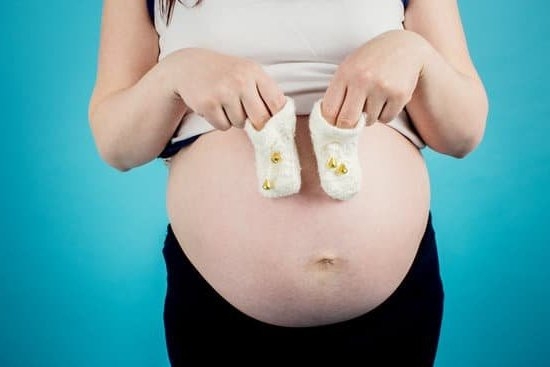When does the third trimester of pregnancy start? The third trimester marks a crucial phase in the journey of pregnancy, characterized by significant physical, emotional, and developmental changes for both the mother and the baby. As expectant mothers approach this final stretch of their pregnancy, understanding what to expect during this period is essential for their well-being and preparation for childbirth.
The third trimester typically begins around week 28 of pregnancy and lasts until the baby’s birth, which is around week 40. This stage is crucial as it signifies the final months leading up to delivery, where the baby undergoes rapid growth and development while the mother experiences various bodily transformations to prepare for labor and motherhood.
During this period, expectant mothers may experience a wide range of physical symptoms such as increased fatigue, swelling in the extremities, backaches, frequent urination, and Braxton Hicks contractions. These discomforts are common as the body adapts to accommodate the growing baby and prepare for labor. Understanding these changes can help mothers navigate this phase with more ease and comfort.
What Is the Third Trimester
The third trimester of pregnancy typically begins around week 28 and lasts until the baby is born, which is usually around week 40. This final stretch of pregnancy is a crucial period as the baby undergoes significant growth and development while preparing for life outside the womb. During this time, many expectant mothers may experience a mix of excitement and anticipation, along with physical discomforts and emotional changes.
As the third trimester progresses, the baby’s organs continue to mature and develop. The lungs are one of the last organs to fully form, so fetal lung development becomes a top priority during this phase. Additionally, the baby starts to gain more weight, store fat, and fine-tune its sensory abilities. Many pregnant women will also notice an increase in fetal movement as their babies grow bigger and stronger in the confined space of the uterus.
For expecting mothers, the third trimester can bring about a range of physical changes and discomforts. Common symptoms include back pain, frequent urination, swelling in the feet and ankles, shortness of breath, heartburn, and difficulty sleeping.
It is also not uncommon for women to experience Braxton Hicks contractions or false labor pains during this time. Proper self-care practices such as staying hydrated, eating nutritious foods, getting regular exercise (if approved by your healthcare provider), and managing stress levels can help alleviate some of these uncomfortable symptoms when does the third trimester of pregnancy start.
Physical Changes
The third trimester of pregnancy typically begins around the 28th week and lasts until the 40th week, which is considered full-term. This stage is crucial as it marks the final stretch before childbirth and involves significant physical changes for the mother as her body prepares for delivery.
One of the most noticeable symptoms that occur during this trimester is weight gain, which can vary depending on individual factors. On average, women are expected to gain about a pound per week in the third trimester.
Another common physical symptom experienced during the third trimester is increased back pain and discomfort. As the baby continues to grow and puts more pressure on the mother’s spine, backaches become more frequent. Additionally, many women may also face challenges with swelling in their feet, ankles, and hands due to fluid retention. This swelling or edema is typically more pronounced during hot weather or after long periods of standing.
Furthermore, pregnant women often report feeling fatigued and having trouble sleeping well in the third trimester. As the baby’s size increases, finding a comfortable sleeping position becomes challenging, leading to restlessness at night. Moreover, frequent urination continues due to pressure on the bladder from the expanding uterus. These physical changes can vary in intensity from woman to woman but are generally considered normal during this late stage of pregnancy.
| Physical Symptom | Description |
|---|---|
| Weight Gain | Expect to gain about a pound per week on average |
| Back Pain | Increased discomfort due to pressure from growing baby |
| Swelling (Edema) | Common in feet, ankles, and hands from fluid retention |
Fetal Development
The third trimester of pregnancy starts around week 28 and lasts until the baby is born, typically around week 40. This phase is crucial for the development of the baby as they continue to grow and mature in preparation for birth. During this stage, the fetus undergoes significant changes, both internally and externally. From gaining weight to developing vital organs, the third trimester is a period of rapid growth for the baby.
One important aspect of fetal development during the third trimester is the maturation of the baby’s lungs. By around week 32, the lungs start producing surfactant, a substance that helps them expand and contract properly after birth.
Additionally, during this time, the baby’s brain continues to develop rapidly, forming complex structures that will govern various functions later in life. The final weeks are critical for further brain growth and fat accumulation under the skin to regulate body temperature after birth.
As the fetus grows larger in the womb during the third trimester, movements may become more pronounced and noticeable to expecting mothers. As space becomes limited inside the uterus, babies tend to settle into a head-down position in preparation for labor and delivery. This positioning is essential for a smooth childbirth process. Overall, this phase marks a period of intense growth and preparation as both mother and baby get ready for what lies ahead.
| Fetal Development Milestone | Weeks |
|---|---|
| Lung Development | Around 32 weeks |
| Brain Maturation | Throughout third trimester |
| Fat Accumulation | Final weeks before birth |
Emotional Changes
During the third trimester of pregnancy, women often experience a wide range of emotional changes as they prepare for the arrival of their baby. This period, which typically begins around week 28 and lasts until delivery, can be filled with heightened emotions, anxiety, excitement, and anticipation. It is important for expectant mothers to recognize and address these feelings to ensure a healthy mindset during this crucial time.
Here are some common emotional changes that pregnant women may experience during the third trimester:
- Increased anxiety about labor and delivery
- Worries about becoming a parent and caring for a newborn
- Feelings of impatience as the due date approaches
- Mood swings due to hormonal fluctuations
- Excitement mixed with fear about the upcoming major life change
It is completely normal for expectant mothers to feel overwhelmed by these emotions, but it is essential to seek support from loved ones, healthcare providers, or even professional counselors if needed. Open communication with a partner or support system can help alleviate stress and provide reassurance during this emotionally turbulent time. Remember that self-care practices such as relaxation techniques, exercise, adequate rest, and healthy nutrition can also contribute to maintaining emotional well-being during the third trimester.
In addition to addressing emotional changes individually, joining support groups or attending prenatal classes can also provide valuable insights and camaraderie with other expectant mothers going through similar experiences. Remember that taking care of your mental health is just as important as physical health during pregnancy. Don’t hesitate to reach out for help when does the third trimester of pregnancy start
Health Tips
During the third trimester of pregnancy, maintaining health and wellness becomes increasingly important as the body undergoes significant changes to support the baby’s growth and prepare for childbirth. As the due date approaches, pregnant women may experience a variety of physical discomforts such as back pain, fatigue, swelling, and frequent urination. To cope with these symptoms and promote overall well-being, here are some practical health tips to consider during this crucial stage of pregnancy.
Stay Active
Regular physical activity can help alleviate some common discomforts of the third trimester such as back pain and swelling. Low-impact exercises like walking, swimming, prenatal yoga, or light stretching can be beneficial. It is important to consult with your healthcare provider before starting any exercise routine during pregnancy to ensure it is safe for you and your baby. Staying active can also help maintain a healthy weight gain and improve mood by releasing endorphins.
Eat a Balanced Diet
Nutrition plays a vital role in supporting your baby’s growth and development during the third trimester. Eating a balanced diet rich in fruits, vegetables, whole grains, lean proteins, and healthy fats is essential. Make sure to stay hydrated by drinking plenty of water throughout the day. Avoid excessive sugar, caffeine, and processed foods while focusing on nutrient-dense options that provide essential vitamins and minerals for you and your baby.
Get Adequate Rest
During the final months of pregnancy when does the third trimester start?, getting enough rest becomes increasingly important. Your body is working hard to nurture the growing baby, so prioritize sleep and relaxation whenever possible.
Consider establishing a bedtime routine, taking naps during the day if needed, using pillows for support while sleeping, or practicing relaxation techniques like deep breathing or meditation to promote better sleep quality. Proper rest is crucial for your overall well-being and energy levels as you prepare for labor and delivery.
Medical Check-Ups
Importance of Prenatal Appointments
Regular prenatal check-ups during the third trimester of pregnancy are crucial for monitoring both the health of the mother and the growth and development of the baby. These appointments allow healthcare providers to assess any potential risks or complications that may arise as the pregnancy progresses.
Health professionals can also provide guidance on proper nutrition, exercise, and overall well-being during this critical stage. Additionally, prenatal visits during the third trimester offer expectant parents the opportunity to ask questions, address concerns, and ensure that they are prepared for labor and delivery.
What to Expect During Third Trimester Visits
During each prenatal appointment in the third trimester, healthcare providers will typically monitor vital signs such as blood pressure, weight gain, and fetal heart rate. They may also perform routine tests such as urine analysis, blood tests, and ultrasounds to ensure that both mother and baby are healthy.
In addition to physical assessments, discussions about labor preparation, childbirth options, postpartum care, and breastfeeding support may take place. These appointments also serve as a time to review any changes or symptoms experienced by the mother since the previous visit.
Managing Expectations
It is essential for expectant mothers to maintain open communication with their healthcare team throughout the third trimester. Understanding what to expect during prenatal appointments can help alleviate anxiety and uncertainty that often come with pregnancy.
By actively participating in these visits and following medical recommendations, pregnant individuals can feel empowered and confident as they navigate through the final stage of pregnancy. Remember that every woman’s pregnancy journey is unique, so it is important to trust in your healthcare provider’s expertise while advocating for your own needs and preferences when necessary.
Preparing for Labor
As pregnant women enter the third trimester of pregnancy, which typically starts around the 28th week, it is important to start preparing for labor and childbirth. Understanding the signs of labor can help expectant mothers recognize when the time is near and make necessary preparations. Some common signs include regular contractions, water breaking, and a bloody show. It is essential to be aware of these indicators to avoid any last-minute rush or confusion.
To prepare for childbirth during the third trimester, creating a birth plan can be helpful. A birth plan outlines your preferences for labor and delivery, including your desired pain management options, delivery positions, and who you want present during the birthing process. Discussing your birth plan with your healthcare provider can ensure that your wishes are respected as much as possible during this significant event.
Additionally, taking prenatal classes can provide valuable information on breathing techniques, relaxation methods, and what to expect during labor and delivery. These classes not only educate expecting parents but also offer opportunities to ask questions and alleviate any fears or concerns about childbirth. Being informed and prepared for labor can help reduce anxiety and increase confidence as the due date approaches.
- Understand the signs of labor.
- Create a birth plan.
- Attend prenatal classes for education and preparation.
Conclusion
The third trimester of pregnancy is a crucial period that marks the final stretch of the pregnancy journey. It officially begins when you reach week 28 and lasts until you give birth, typically around week 40. This phase is not only significant due to the imminent arrival of your baby but also because of the physical, emotional, and psychological changes that both mother and baby undergo during this time.
As the body continues to prepare for childbirth, women may experience a variety of physical symptoms such as back pain, frequent urination, swelling in the feet and ankles, and difficulty sleeping. These discomforts can be challenging, but they are all part of the body’s natural process in getting ready for labor. On the other hand, fetal development reaches critical milestones during this trimester, with the baby gaining weight and developing organs at a rapid pace.
Emotionally, many pregnant women find themselves on a rollercoaster ride during the third trimester. Anxiety about childbirth and becoming a parent may be coupled with excitement to finally meet their little one. It is essential to prioritize self-care and reach out for support from loved ones during this time.
Remember that every individual’s pregnancy journey is unique; therefore, it is crucial to listen to your body and seek guidance from healthcare providers when necessary. As you navigate through these final weeks before welcoming your baby into the world, remember to cherish this period and trust in your body’s incredible ability to bring new life into existence.
Frequently Asked Questions
Is 3rd Trimester 27 or 28 Weeks?
The 3rd trimester officially begins at the 28th week of pregnancy, not the 27th week. This is the final stretch before giving birth, characterized by more physical discomfort and preparing for labor.
When Am I Officially in My 3rd Trimester?
You are officially in your 3rd trimester once you reach the 28th week of pregnancy. This is an important milestone as you enter the final three months before meeting your baby.
Which Trimester Is the Hardest?
Many women find the first trimester to be the hardest due to symptoms like nausea and fatigue. However, others may find the third trimester to be most challenging because of increased discomfort, difficulty sleeping, and anxiety about labor and delivery. Each trimester has its unique set of challenges for expectant mothers.

Welcome to my fertility blog. This is a space where I will be sharing my experiences as I navigate through the world of fertility treatments, as well as provide information and resources about fertility and pregnancy.





